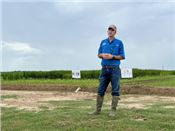New Rice Varieties Ozark, Taurus And A Roma 22 Highlighted At Rice Field Day
JOHN LOVETT
FAYETTEVILLE, ARKANSAS
In addition to several new long-grain rice varieties, the Arkansas Agricultural Experiment Station’s Rice Breeding Program has one new medium-grain variety and two new aromatic lines in the pipeline.
During the University of Arkansas System Division of Agriculture’s 2022 Rice Field Day at the Rice Research and Extension Center near Stuttgart on Aug. 5, over 250 attendees heard from experiment station rice breeders Xueyan Sha and Christian De Guzman on developments of several new varieties like Ozark, the new short-season long grain, and Taurus, a new high-yielding medium-grain rice. The experiment station is the research arm of the Division of Agriculture.
ARoma 22, the new conventional jasmine-type aromatic rice from the Division of Agriculture, was highlighted alongside two new aromatic lines in development. ARoma 22 offers increased aromatics and color consistency over its predecessor, and equals several qualities looked for by consumers of imported Asian aromatic rice, sensory tests show.
John Carlin, director of the division’s Arkansas Crop Variety Improvement Program, said the aromatic program has started to shift toward breeding for higher quality, and two promising lines in the program will be evaluated for improved quality and agronomy characteristics.
ARoma 22 averaged 167 bushels per acre with high milling yields in five Arkansas Rice Variety Advancement Trials. The new aromatic rice reaches 50 percent heading at 88 days with “excellent” straw strength, according to data collected from the Arkansas Uniform Rice Regional Nursery and reported in 2020 research trials. It is moderately susceptible to blast, sheath blight, bacterial panicle blight, and susceptible to false smut.
Long-grain
Seed stock for Ozark, the newest Division of Agriculture conventional long-grain, is showing a 10-bushel-per-acre yield advantage over its predecessors, Diamond and LaKast, Sha said. Ozark’s consistent yield potential is complemented by its good milling and grain quality and good straw strength, he added.
About 12 acres of Ozark foundation seed were grown at the experiment station this year for an expected release to seed dealers in 2023, Sha said.
Foundation seed for Clearfield® varieties CLL16 and CLL18 continue to be grown by the Arkansas Agricultural Experiment Station in collaboration with BASF/Horizon Ag. Both are short-season long-grain varieties, with CLL16 hitting the public market just last year. CLL18 is expected to be publicly available in 2023 through Horizon Ag.
CLL18 was the highest yielding nonhybrid Clearfield® rice in the 2020 and 2021 Arkansas Rice Performance Trials conducted by the Division of Agriculture, averaging 221 bushels of rough rice per acre.
The milling yield average for CLL18 over the two-year, 2020-2021 Arkansas Rice Variety Advancement Trials was 59 percent whole kernel and 69 percent total milled rice. The variety averaged 50 percent heading in 87 days.
CLL18 has a plant height of 37 inches with grain weight, kernel size and lodging resistance like Diamond, and early maturity similar to CLL15.
While moderately resistant to narrow brown leaf spot, CLL18 is moderately susceptible to common rice blast, to sheath blight, bacterial panicle blight and false smut.
CLL16 has a rough rice yield potential like Diamond’s at about 205 bushels per acre yield, with low chalk, good milling, and the Pi-ta gene for blast resistance, Sha said.
Milling yields for CLL16 averaged 63 percent whole kernel and 69 percent total milled rice for samples from Arkansas Rice Performance Trials across the state. CLL16 is a very stable cultivated variety with an early maturity date, averaging 86 days to 50 percent heading, similar to CL172 and Wells, and about four days earlier than Roy J.
The plant is standard height with a 36-inch canopy, similar to Diamond.
Clearfield® rice was developed at Louisiana State University from a breeding line of rice with a naturally occurring genetic mutation that was tolerant to the imidazoline family of herbicides, said Bob Scott, Rice Research and Extension Center director.
Medium-grain
Taurus is a semi-drawf conventional variety with a 20-bushel per acre yield advantage over its predecessors.
Taurus offered an average yield potential of 232 bushels per acre in the 2021 Arkansas Rice Variety Advancement Trials, said Sha, senior rice breeder for the Agricultural Experiment Station.
Sha said Taurus was bred for Midsouth conditions and would be adaptable to wherever Jupiter or Titan are grown. A cross between four other conventional varieties, Taurus has a plumper kernel than Jupiter and outshined the latest medium-grain varieties, Lynx and Titan, in the 2021 trials at six locations. Taurus brought in the highest average yield in a Clay County field with 249 bushels per acre.
Arkansas rice update
Jarrod Hardke, professor and rice extension agronomist for the Division of Agriculture’s Cooperative Extension Service, said farmers planted an estimated 1.15 million acres of rice in Arkansas this year.
“The crop so far looks very good,” Hardke said Aug. 8. “Despite overall later planting, the heat of the summer moved things along very quickly. Harvest is expected to begin soon as a result, though the bulk of acres still have a few weeks to go before we really get into harvest full swing.”
Hardke also noted that while 2022 has been a difficult season and yields will not likely challenge the record yields in 2021, he is still “very optimistic” on yields.
“The combines, as always will tell the story,” Hardke said. ∆
JOHN LOVETT: University of Arkansas

Rice breeder Christian De Guzman speaks about rice variety improvements during the Division of Agriculture's Rice Field Day Aug. 5, 2022.
U of A System Division of Agriculture photo by Mary Hightower

Rice breeder Xueyan Sha discusses varieties at the Aug. 5, 2022, Rice Field Day at the Rice Research and Extension Center in Stuttgart, Arkansas.
U of A System Division of Agriculture photo by Mary Hightower

Extension rice agronomist Jarrod Hardke provides an update to attendees at the Aug. 5, 2022, Rice Field Day at the
Rice Research and Extension Center in Stuttgart, Arkansas.
U of A System Division of Agriculture photo by Mary Hightower